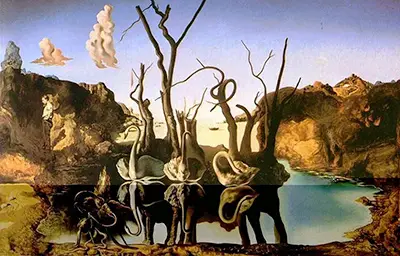It comes from what he termed his “Paranoic-critical” period. Inspired by Freud, Dali would induce a state of paranoia to allow his brain to create unseen links between objects.
In Swans Reflecting Elephants, Dali uses double images to transfigure graceful swans into huge, land-locked animals.
As in his earlier work, Metamorphosis of Narcissus, he uses water to reflect alternative realities.
Here, the trees of the Catalan landscape merge with the swans' reflections to create elephants in a technically brilliant painting.
The swans are carried upon the elephants backs through the stark landscape whilst a lone figure blends into the background, his back to the scene. Swans Reflecting Elephants is currently in a private collection.
Salvador Dali, known for his melting clocks and lobster telephones, was a larger than life figure who featured prominently in the 20th Century art world.
Easily recognisable from his signature waxed moustache, he was known as much for his eccentricity as for his place in the Surrealist Movement.
As well as being an artist, Dali was a writer and involved in films, notably Le Chien Andalou with Luis Buñuel, and Alfred Hitchcock's, Spellbound.
Salvador Dali was born in the Catalonian town of Figueres in 1904. As a child, he was told he was the reincarnation of his deceased brother, also called Salvador. In later life, Dali stated that he and his brother "resembled each other like two drops of water”, but with “different reflections."
References to the dead Salvador appear in Dali's work, most obviously in Portrait of My Dead Brother. A precocious child, he had his first exhibition of drawings in 1917, at the age of 13, at his family home.
Dali studied art in Madrid and exhibited regularly there and in Barcelona. He was heavily influenced by the Spanish painters, Pablo Picasso and Joan Miró. In 1927 he travelled to Paris where he met his idol, Picasso. Picasso had already heard positive things about Dali's work from Miró.
In 1929 Dali visited Paris again. He had been using surrealist ideas in his work for some time and Miró introduced him to the leader of the French Surrealist Movement, André Breton. Although originally embraced by the movement, Dali clashed with Breton.
He was eventually expelled for his apolitical stance and self-promotion. Despite the surrealist nature of his art, Breton felt Dali did not fit with the ideology of Surrealism as a revolutionary movement.
This is possibly born out by Dali's involvement in commercial enterprises, including designing the logo for Chupa Chups lollies!
Dali made his main home in Cadaqués, near his birthplace of Figueres. He and Gala, his wife and muse, created the Teatro-Museo Dali, The Dali Theatre-Museum, in the former Municipal Theatre of Figueres.
Dali spent the last years of his life living in the museum's tower, the Torre Galatea and is buried in a crypt in the main exhibition space.
Exploring the museum is like exploring the facets of Dali's mind; you are never sure if it is the mind of a brilliant creator or of a madman, or of both.

